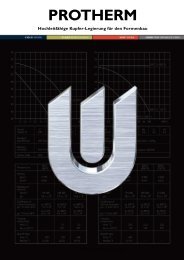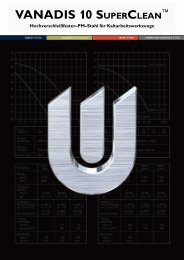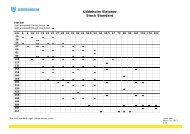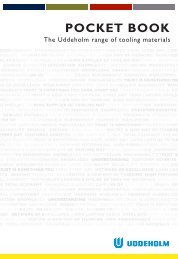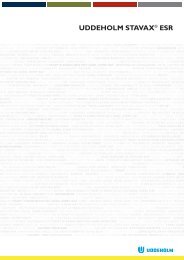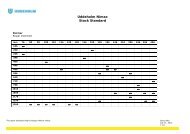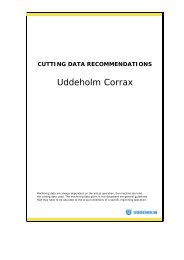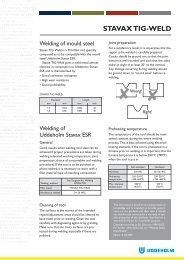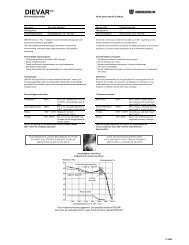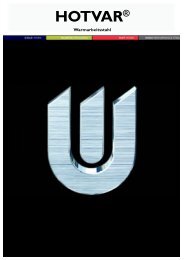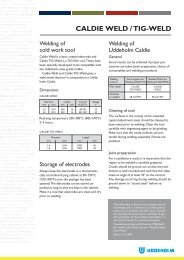download - Uddeholm
download - Uddeholm
download - Uddeholm
Create successful ePaper yourself
Turn your PDF publications into a flip-book with our unique Google optimized e-Paper software.
HAGFORS KLARTEXT U070407.500 / TRYCKERI KNAPPEN, KARLSTAD 200704223<br />
The breadth of the joint bottom should be at<br />
least 1 mm greater than the diameter of the<br />
electrode plus coating. Any damage occurring<br />
during welding should be ground down to<br />
“sound steel” before re-welding.<br />
✘<br />
Wrong!<br />
Preheating temperature<br />
Right!<br />
✘<br />
The temperature of the tool during the entire<br />
welding process should be maintained at an<br />
even level. This is best achieved using electrical<br />
heating elements.<br />
If the tool is preheated in a furnace prior to<br />
welding, then it is important that the furnace<br />
temperature is below 200°C (390°F) when the<br />
tool is put in.<br />
Soft<br />
Preannealed<br />
Hardened hardened<br />
Hardness 200 HB 58 HRC 56 HRC 240–270 HB<br />
Preheating 200–250°C 180°C 220°C 200–250°C<br />
temperature (390–485°F) (355°F) (430°F) (390–485°F)<br />
Max. interpass 400°C 250°C 350°C 400°C<br />
temperature (750°F) (485°F) (660°F) (750°F)<br />
Small repairs can be made at room temperature<br />
with the TIG-method. For MMA-welding<br />
preheating is recommended.<br />
Use a short arc and weld in separate runs. Do<br />
not oscillate the gun. Angle the electrode 90°<br />
to the joint sides in order to avoid undercut. In<br />
addition, the electrode should be held at an<br />
angle of 75–85° to the direc-tion of forward<br />
movement.<br />
For small repairs and for the final runs along<br />
the fusion line, TIG-welding is to be preferred.<br />
The transition region between weld and base<br />
steel should be carefully inspected prior to<br />
stopping welding. Arcing sores or undercut<br />
should be repaired while the tool is still hot.<br />
After welding, the final layer of weld metal is<br />
ground away prior to any heat treatment.<br />
If the tool is to be polished or photo-etched<br />
TIG welding is to be preferred so that pores,<br />
arcing sores or undercut can be avoided.<br />
For more detailed information, see the<br />
<strong>Uddeholm</strong> brochure “Welding of Tool Steels”.<br />
Post treatment<br />
Soft<br />
Preannealed<br />
Hardened hardened<br />
Hardness 200 HB 58 HRC 56 HRC 240–270 HB<br />
Cooling<br />
rate<br />
TEMPERING GRAPH FOR FILLER MATERIAL<br />
Hardness as welded 58–61 HRC.<br />
HRC<br />
65<br />
20–40°C/h (35–70°F/h) for the first<br />
2 hours then freely in air<br />
Heat Soft anneal Temper Temper Stress relieve<br />
treatment Harden 200°C 275°C 550°C<br />
Temper (390°F) (520°F) (1020°F)<br />
2 h 2 h 2 h<br />
Building up the weld<br />
The root runs should be made with a small<br />
diameter electrode (Ø max. 3,25 mm). If TIGwelding,<br />
the current should be limited to 120 A.<br />
The first two runs should always be welded<br />
with the same low heat input, while a greater<br />
heat input can be used for the remaining layers.<br />
Ensure that the heat from each run tempers<br />
the previous run. Hence even for very minor<br />
repairs, the minimum number of runs should be<br />
two.<br />
60<br />
55<br />
50<br />
45<br />
40<br />
35<br />
30<br />
100 200 300 400 500 600°C<br />
212 392 572 752 932 1112°F<br />
Holding time 2 x 2h<br />
FURTHER INFORMATION<br />
Please contact your local <strong>Uddeholm</strong> office for further information on the selection, heat treatment, application and<br />
availability of <strong>Uddeholm</strong> tool steels. For more information, please visit www.uddeholm.com or www.assab.com



